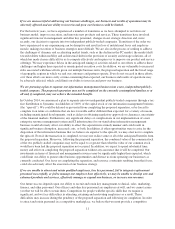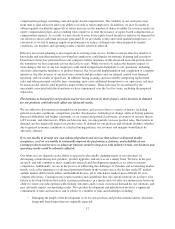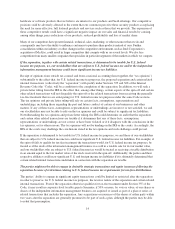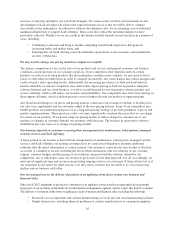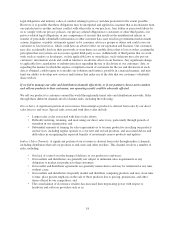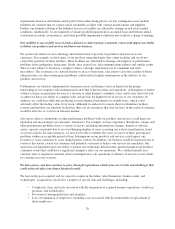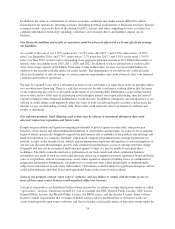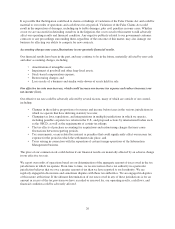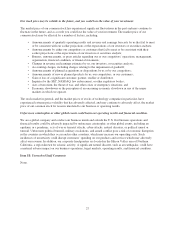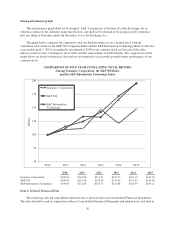Symantec 2015 Annual Report Download - page 98
Download and view the complete annual report
Please find page 98 of the 2015 Symantec annual report below. You can navigate through the pages in the report by either clicking on the pages listed below, or by using the keyword search tool below to find specific information within the annual report.requirements based on our business needs prior to firm orders being placed, our loss contingencies may include
liabilities for contracts that we cannot cancel, reschedule or adjust with contract manufacturers and suppliers.
Further, our estimates relating to the liabilities for excess facilities are affected by changes in real estate market
conditions. Additionally, we are required to evaluate goodwill impairment on an annual basis and between annual
evaluations in certain circumstances, and future goodwill impairment evaluations may result in a charge to earnings.
Our inability to successfully recover from a disaster or other business continuity event could impair our ability
to deliver our products and services and harm our business.
We are heavily reliant on our technology and infrastructure to provide our products and services to our
customers. For example, we host many of our products using third-party data center facilities and we do not
control the operation of these facilities. These facilities are vulnerable to damage, interruption or performance
problems from earthquakes, hurricanes, floods, fires, power loss, telecommunications failures and similar events.
They are also subject to break-ins, computer viruses, sabotage, intentional acts of vandalism and other
misconduct. The occurrence of a natural disaster or an act of terrorism, a decision to close the facilities without
adequate notice or other unanticipated problems could result in lengthy interruptions in the delivery of our
products and services.
Furthermore, our business administration, human resources and finance services depend on the proper
functioning of our computer, telecommunication and other related systems and operations. A disruption or failure
of these systems or operations because of a disaster or other business continuity event could cause data to be lost
or otherwise delay our ability to complete sales and provide the highest level of service to our customers. In
addition, we could have difficulty producing accurate financial statements on a timely basis, which could
adversely affect the trading value of our stock. Although we endeavor to ensure there is redundancy in these
systems and that they are regularly backed-up, there are no assurances that data recovery in the event of a disaster
would be effective or occur in an efficient manner.
Any errors, defects, disruptions or other performance problems with our products and services could harm our
reputation and may damage our customers’ businesses. For example, we may experience disruptions, outages and
other performance problems due to a variety of factors, including infrastructure changes, human or software
errors, capacity constraints due to an overwhelming number of users accessing our website simultaneous, fraud
or security attacks. In some instances, we may not be able to identify the cause or causes of these performance
problems within an acceptable period of time. Interruptions in our products and services could impact our
revenues or cause customers to cease doing business with us. In addition, our business would be harmed if any of
events of this nature caused our customers and potential customers to believe our services are unreliable. Our
operations are dependent upon our ability to protect our technology infrastructure against damage from business
continuity events that could have a significant disruptive effect on our operations. We could potentially lose
customer data or experience material adverse interruptions to our operations or delivery of services to our clients
in a disaster recovery scenario.
We have grown, and may continue to grow, through acquisitions, which gives rise to risks and challenges that
could adversely affect our future financial results.
We have in the past acquired, and we expect to acquire in the future, other businesses, business units, and
technologies. Acquisitions can involve a number of special risks and challenges, including:
• Complexity, time, and costs associated with the integration of acquired business operations, workforce,
products, and technologies;
• Diversion of management time and attention;
• Loss or termination of employees, including costs associated with the termination or replacement of
those employees;
20



